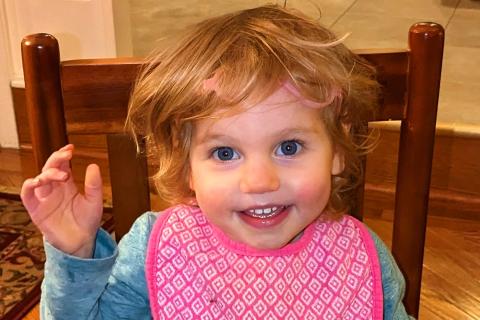
“She had trouble breathing,” says Lisa. “At first, they just thought maybe she might have some fluid stuck in her lungs. Or it was pulmonary hypertension. Something fixable.” But after about a half hour, the hospital team still couldn’t get Leah breathing correctly—and their newborn was sent to the Neonatal Intensive Care Unit at the hospital. That, says Lisa, started their journey.
The medical team tried one procedure after the other, but Leah’s breathing problems continued. Soon, the infant was in a helicopter and on the way to a children’s hospital. The couple was told that Leah would take time to stabilize, but they were still hopeful. “We thought it was a case of ‘when’ not ‘if’ she would leave the hospital. At the time, we didn’t know she was fighting for her life.”
After the next few weeks, Leah’s condition worsened. She was put on oxygen and began needing higher and higher levels. The medical team did a lung biopsy and finally, a genetic scan—which revealed the source of her problems: It was ABCA3 surfactant deficiency.
A rare condition, it’s a genetic mutation which affects the molecules lining the tissue in the lungs, making it hard for the air sacs to expand and contract during breathing. The average life span for a baby with this deficiency is 3 to 6 months.
“That’s when we first began hearing about a lung transplant,” Lisa says. At the age of two months, Leah was put on the transplant list and a tense wait began.
She was also requiring more and more oxygen and ventilator support, and at 4 months, few options were left. One was an ECMO pump, a machine that oxygenates the blood, used only in critical care. “The problem is it’s dangerous for a baby her age,” the couple recalls. “But that’s the point we had reached.”
Lou and Lisa did some soul-searching. They asked themselves if hospice would be better for the little girl. But they chose to try the ECMO pump, still hoping for a donor.
After three days on ECMO, at 9:00 on a Saturday morning, they got “the call.” It was one of the transplant doctors. “At first I thought she was calling just to check on us,” says Lisa. “But she said she had some news. ‘We’ve found a donor. We have lungs.”
At first, her husband thought the worst had happened. “Lisa was just screaming,” Lou says. But soon the whole family knew the good news. They had a match.
While so much could still go wrong, the couple went to the hospital early with high hopes. Finally, the donor lungs arrived, and the surgery began late that night. The next morning, the couple were allowed to see Leah. She was receiving only 50% oxygen, down from 100% oxygen in just a few hours.
What did it feel like to come in and see her responding so well? “It felt like hope again,” says Lou. “It felt like our nightmare was over.”
Leah began her recovery slowly—she was still a baby—but at the age of ten months, she finally came home! While the road to recovery has had its bumps, the family is now…as Lisa says, almost like a “normal” family.
Leah will soon turn three and the family is cautiously starting daycare. After all, Lisa points out, lungs are the only organ exposed to the outside environment, so you have to be careful.
With so many people still waiting for transplants, we asked Lou and Lisa what they would say to someone still debating signing up as an organ donor.
“I would just hold up Leah,” says Lou. “I would hold her up and ask, ‘Would you rather have her gone? Organ donation saved my daughter.”
You can save or improve the life of someone in need of a transplant. Learn about signing up as an organ, eye, and tissue donor.